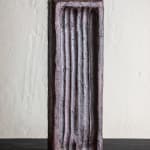




Shiro Shimizu (1979-Present)
Rectangle Plate, 2017
Fired Clay
3 3/4'' x 14 1/4'' x 1"
Further images
Shiro Shimizu’s work possesses a wild audacity, delicateness, refinement, and natural warmth. How and why can those seemingly contradicting qualities live together in a piece, all the while bringing about...
Shiro Shimizu’s work possesses a wild audacity, delicateness, refinement, and natural warmth. How and why can those seemingly contradicting qualities live together in a piece, all the while bringing about such refined elegance?
Part of the answer lies simply in how he prepares his clay and bakes his works, which runs contrary to the practice of most potters. For the past 100 years or so, modern potters have bought various materials from specialized stores, turned the wet clay into pottery on an electric wheel, and baked it in a readymade electric or gas kiln. This method is convenient. All of the fail-safe precautions are built in to the materials just like the auto-correcting camera of the newest iPhone. Anyone with a tiny amount of skill can make reasonable works this way.
Shiro-san refuses it. He searched for his own clay by traveling the various regions of Japan. Sometimes, when he finds a truly good patch, he constructs a kiln right then and there on location to create his works. Otherwise he brings the clay back to his studio in Kyoto, where he works with his grandfather and father at their family’s kilns.
Shimizu communicates directly with each clod of earth, and together they collaborate to make potteries. This is not a new wave or movement, at all. Japanese potteries had always been made in this way before the modern era. This is one of the reasons that his work has the quiet vigor of very old pottery, while still possessing an utterly contemporary power and artistic energy.
This work is, well, what is this? It is simply a rectangle of clay with lines that run like rows of tilled earth down its longest side. It represents Shimizu’s own conversation with the clod of earth in his hands. How to introduce it into the living space depends on your own conversation with the work. Put it on your shelf as an object d’art, place a few olives between the rows, or rotate it to use as a great pedestal for other artworks. Like the best pieces, it does not confine anything; it only offers new possibilities.
Part of the answer lies simply in how he prepares his clay and bakes his works, which runs contrary to the practice of most potters. For the past 100 years or so, modern potters have bought various materials from specialized stores, turned the wet clay into pottery on an electric wheel, and baked it in a readymade electric or gas kiln. This method is convenient. All of the fail-safe precautions are built in to the materials just like the auto-correcting camera of the newest iPhone. Anyone with a tiny amount of skill can make reasonable works this way.
Shiro-san refuses it. He searched for his own clay by traveling the various regions of Japan. Sometimes, when he finds a truly good patch, he constructs a kiln right then and there on location to create his works. Otherwise he brings the clay back to his studio in Kyoto, where he works with his grandfather and father at their family’s kilns.
Shimizu communicates directly with each clod of earth, and together they collaborate to make potteries. This is not a new wave or movement, at all. Japanese potteries had always been made in this way before the modern era. This is one of the reasons that his work has the quiet vigor of very old pottery, while still possessing an utterly contemporary power and artistic energy.
This work is, well, what is this? It is simply a rectangle of clay with lines that run like rows of tilled earth down its longest side. It represents Shimizu’s own conversation with the clod of earth in his hands. How to introduce it into the living space depends on your own conversation with the work. Put it on your shelf as an object d’art, place a few olives between the rows, or rotate it to use as a great pedestal for other artworks. Like the best pieces, it does not confine anything; it only offers new possibilities.
Signup for our Newsletter
You will receive two emails a month from us. One introduces artworks and design works from Kyoto's hidden sources and the other is stories from Misako, sharing insights into Japanese culture.
* denotes required fields
为了回应您的查询,我们将根据我们的隐私政策处理您提供的个人数据。




